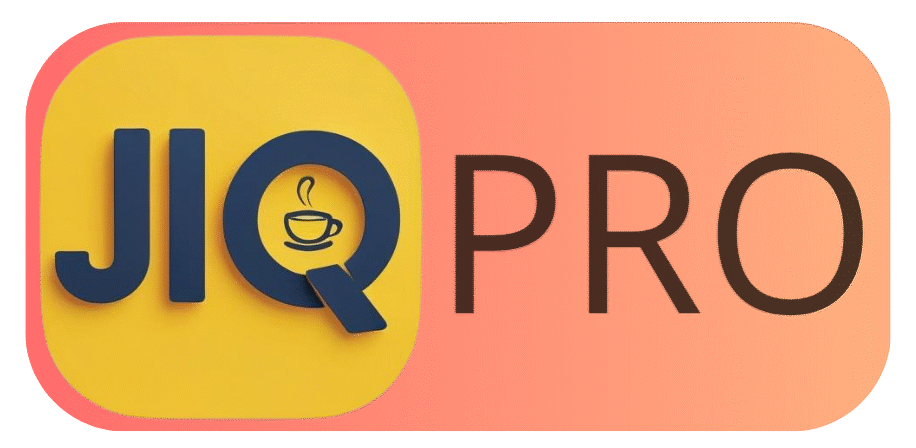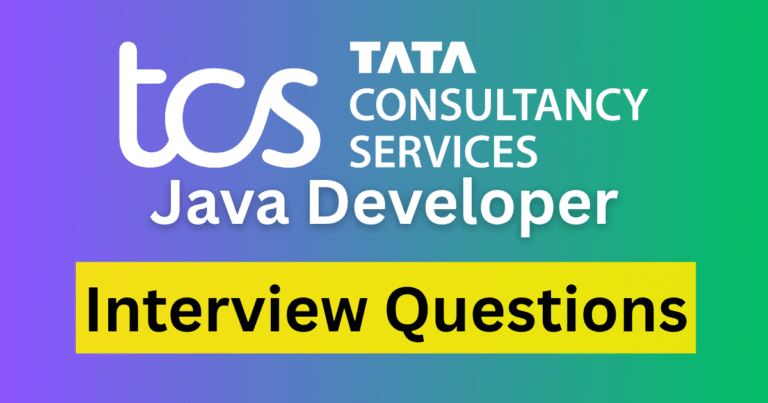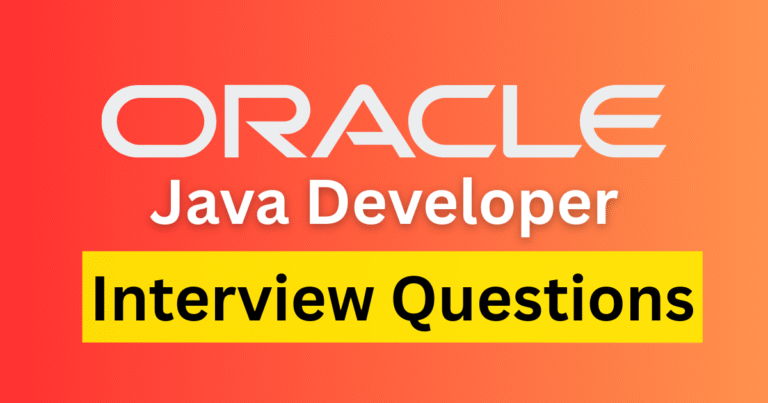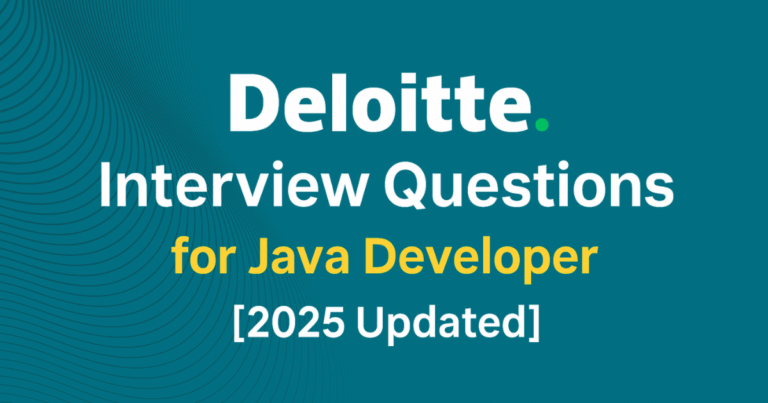Top Accenture Java Interview Questions 2025
If you’re looking for the latest Accenture Java Interview Questions in 2025, you’re in the right place. Whether you’re a fresher, have 3 years of experience or are appearing for a Java Full Stack role, this covers everything you need—from core Java to Spring Boot and microservices, along with sample programming questions.
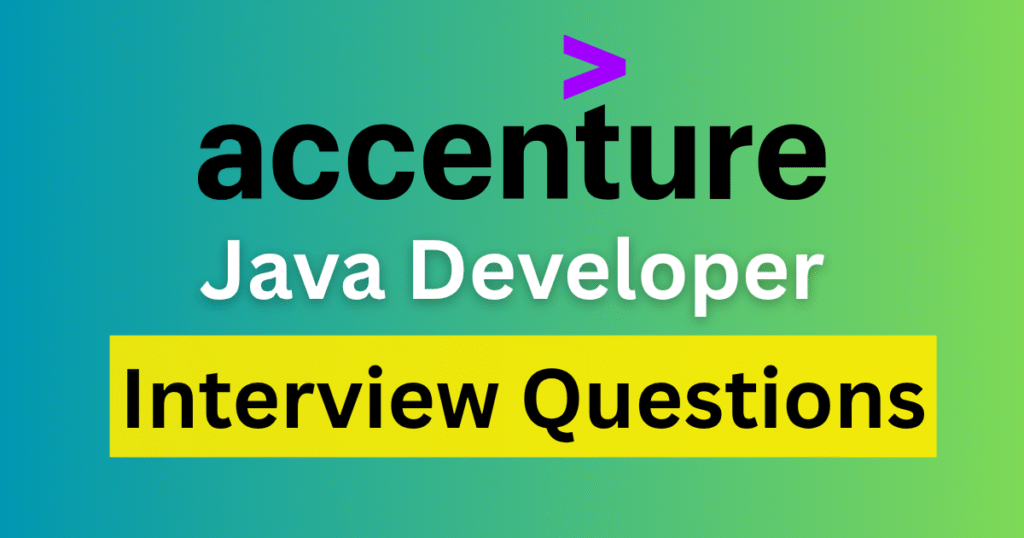
This guide includes:
- ✅ Frequently and Recently asked Accenture Java developer interview questions
- 🧠 Realistic, interview-style answers
- 📌 Specific to Accenture Java Spring Boot Interview Questions
- 💡 Relevant for both freshers and experienced professionals
Core Accenture Java Interview Questions
1. What are OOPs concepts? Is multiple inheritance possible in Java?
In Java, the core OOPs concepts are:
- Encapsulation
- Inheritance
- Abstraction
- Polymorphism
Multiple inheritance with classes is not supported to avoid ambiguity (diamond problem). However, it’s possible using interfaces.
2. What is the difference between Abstract Class and Interface?
An abstract class can have both abstract and concrete methods, while an interface in Java 8 onwards can have default and static methods along with abstract ones. Interfaces are used for full abstraction and multiple inheritance. Abstract classes are preferred when we need shared base functionality.
3. What are the Access Modifiers in Java?
Java provides:
private– accessible only within the class.default– accessible within the package.protected– accessible in the package and by subclasses.public– accessible from anywhere.
4. What is the difference between equals() and ==?
==Checks object reference equality.equals()checks logical equality (values inside objects).
Example:
javaCopyEditnew String("A") == new String("A") // false
new String("A").equals(new String("A")) // true
5. Difference between ArrayList and LinkedList?
ArrayListis backed by arrays → fast for searching.LinkedListis node-based → fast for insertion/deletion.
Use ArrayList when reads are frequent; use LinkedList for frequent adds/removals.
6. What is synchronized in Java?
It is a keyword used to lock an object or method, so that only one thread can access it at a time—used in multithreading to prevent race conditions.
☕ Java 8 Features
7. What are the new features in Java 8?
Key additions:
- Lambda Expressions
- Stream API
- Functional Interfaces
- Optional
- Default & Static Methods in Interfaces
These help write more concise, readable, and functional code.
8. What is a Functional Interface?
An interface with only one abstract method.
Example:
javaCopyEdit@FunctionalInterface
interface MyFunction {
void execute();
}
Common ones: Runnable, Callable, Predicate, Function
9. What is a Lambda Expression?
It’s a way to pass behaviour (functions) as parameters.
Example:
javaCopyEdit(int a, int b) -> a + b
Used heavily with Streams and functional interfaces.
10. What is Stream API?
Stream API helps process data in a declarative functional way.
Example:
javaCopyEditList<Integer> even = list.stream().filter(n -> n % 2 == 0).collect(Collectors.toList());
Spring & Spring Boot
11. What are Spring Boot features? Why is it used?
- Auto Configuration
- Embedded Server (Tomcat/Jetty)
- Spring Boot Actuator
- Standalone setup with minimal config
It’s used to build microservices faster and reduce boilerplate code.
12. What is Dependency Injection (DI)? How did you use it in your project?
DI is a pattern where dependencies are provided to a class, not created by the class.
In my project, I used constructor injection with @Autowired to inject services into controllers.
13. What is @Qualifier?
Used with @Autowired to specify which bean to inject when multiple beans of the same type exist.
javaCopyEdit@Autowired
@Qualifier("customService")
private Service myService;
14. What is @SpringBootApplication?
It’s a meta-annotation that combines:
@Configuration@EnableAutoConfiguration@ComponentScan
It marks the main class of a Spring Boot app.
15. What is a Spring Profile?
Spring Profiles allow setting up different configurations for different environments, like dev/test/prod.
Use:
javaCopyEdit@Profile("dev")
@Bean
public DataSource devDataSource() { ... }
Activate via:
propertiesCopyEditspring.profiles.active=dev
16. What is the default port of Spring Boot?
8080
You can change it using:
propertiesCopyEditserver.port=9090
Microservices Interview Questions
17. What are Microservices?
An architecture style where applications are broken into independent services. Each service runs independently and communicates via REST APIs or messaging queues.
18. How to connect to multiple Microservices?
- Use Eureka (service discovery)
- Use Feign clients for REST calls
- Use API Gateway for routing and security
19. Are REST calls between Microservices synchronized?
Yes, by default they are synchronous using REST (blocking). But for better resilience, we use asynchronous messaging like Kafka or RabbitMQ.
Programming Questions
1. Count the frequency of characters in a String
javaCopyEditMap<Character, Integer> freq = new HashMap<>();
for (char ch : str.toCharArray()) {
freq.put(ch, freq.getOrDefault(ch, 0) + 1);
}
2. Sort an Array [4, 0, 2, 1, 0, 2, 1]
javaCopyEditint[] arr = {4, 0, 2, 1, 0, 2, 1};
Arrays.sort(arr);
System.out.println(Arrays.toString(arr));
Or for only 0,1,2 — use counting sort (aka Dutch National Flag algorithm).
Must-Know Additional Questions
- What is the difference between
@Component,@Service, and@Repository? - How does
Optionalhelp avoidNullPointerException? - How does Garbage Collection work in Java?
- Lifecycle of a Spring Bean
- Global Exception Handling in Spring Boot using
@ControllerAdvice - Difference between Monolithic and Microservices
- What is the Circuit Breaker pattern? (Use Resilience4j or Hystrix)
Conclusion
Whether you’re preparing for Accenture Java Developer Interview for 3 years experience, or you’re a fresher looking for entry-level questions, these topics are crucial.
What should I prepare for the Accenture Java Developer interview if I have 3 years of experience?
For 3 years experience, focus on Core Java (collections, multithreading, exception handling), Java 8 (Stream API, lambdas, functional interfaces), Spring & Spring Boot, RESTful APIs and Microservices, Project experience and real-world use of design patterns.
Are coding questions asked in Accenture Java interviews?
Yes, typically simple to intermediate coding problems are asked, such as: Count frequency of characters in a string, Sort an array, Remove duplicates from a list, Use of Java Streams for data transformation.
What are the important Spring Boot annotations to know?
Key annotations include:@SpringBootApplication@Autowired@RestController@RequestMapping@Qualifier@Component, @Service, @Repository
What is the interview process for a Java developer at Accenture?
Typically, the interview process includes:
Technical Round 1 – Core Java, OOPs, Java 8
Technical Round 2 – Spring Boot, microservices, project-based Qs
HR/Managerial Round – Behavioral, communication, cultural fit
Does Accenture ask questions on Java 8 and Streams?
Absolutely. Questions around Stream API, filter(), map(), collect(), Optional, and lambda expressions are very common, especially for experienced roles.
Is knowledge of Microservices important for the Java role in Accenture?
Yes. If you’re applying for a Java Full Stack or Backend Developer role, Microservices knowledge is expected—especially around: REST communication,
Service discovery (Eureka), Spring Cloud, Feign, and API Gateway, Circuit Breaker concepts (Hystrix/Resilience4j).
Do freshers need to know Spring Boot for Accenture?
Not always. But if you’re applying for a role that includes backend/API development, basic understanding of Spring Boot is an added advantage—even for freshers.
How can I practice for the Accenture Java interview?
Use platforms like LeetCode, HackerRank and GeeksforGeeks with practising Java interview questions from our website javainterviewquestionspro.com and focus on hands-on projects and explain your experience clearly
🙋♂️ Got a Question?
Drop your doubts in the comments below or connect with us on LinkedIn.
